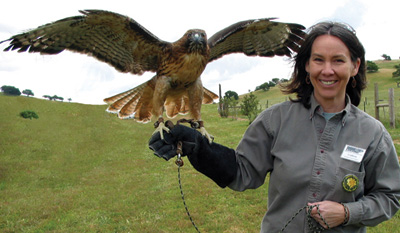All the wild animals that arrive at the Wildlife Education and
Rehabilitation Center have much for which to be thankful: For the
kind-hearted people who go out of their way to rescue creatures
that may be dreadfully injured or orphaned or sick; and for the
dedicated volunteers who treat wounds, set broken bones and
hand-feed those animals too young or weak to eat on their own.
All the wild animals that arrive at the Wildlife Education and Rehabilitation Center have much for which to be thankful: For the kind-hearted people who go out of their way to rescue creatures that may be dreadfully injured or orphaned or sick; and for the dedicated volunteers who treat wounds, set broken bones and hand-feed those animals too young or weak to eat on their own.
Twelve years ago, one very special red-tailed hawk was a fortunate recipient of this TLC. Driving home on Pacheco Pass, a commuter became aware of a truck speeding up closely behind him.
His heart quickened when he saw a hawk ahead of him on the highway shoulder, hungrily eating some road kill.
As the startled raptor attempted to fly off with the food in its talons, the man watched with horror as the truck zoomed around him and purposely swerved off the road, deliberately hitting the hawk and then speeding off. Stunned, but acting with immediacy, the rescuer pulled over, gently gathered up the unconscious, badly injured and bleeding hawk and brought it to WERC
The initial exam showed that hawk had no broken bones, almost unbelievable good fortune considering the force of the collision.
However, the bird suffered massive trauma to its head, and its body was badly bruised. During the long period of rehabilitation, the swelling diminished and the bird’s health gradually and steadily improved with antibiotics and a daily diet of tasty rodents.
Sadly, the hawk’s head injuries had caused permanent blindness to its right eye – the hawk could not be released back to the wild. Perfect sight is essential to the survival of birds-of-prey, which must be able to focus keenly and gauge distances while in pursuit of a meal. Relying on road-kill is not the best or safest survival method, as this hawk proved.
But when one door closes, another often opens. This beautiful young hawk was given the name “Wapeka,” a Native American word meaning “spirited woman” and became one of WERC’s valued animal ambassadors.
For 12 years, Wapeka has visited schools to educate students about our native wildlife and habitats. She is a regular crowd-pleaser at public events and on WERC’s annual Fourth of July parade float, drawing “ohs” and “ahs” when she majestically displays her 4-foot wing span. As red-tailed hawks can live more than 30 years in captivity, Wapeka should be delighting school children for another generation or two.










